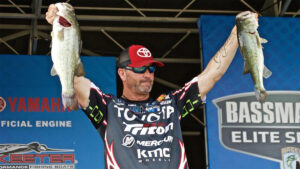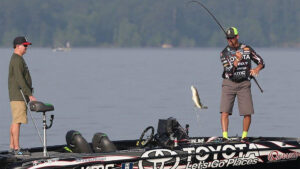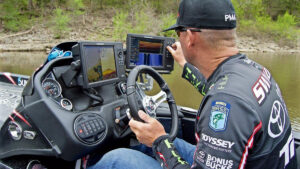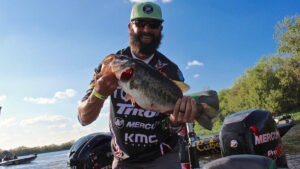Main lake points are excellent targets for bass anglers throughout the entire year. From winter to summer, you can bet there are bass exploiting these points to ambush prey. A bass’s depth and location on a point changes based on a variety of factors, so what exactly makes one point better than another?
Deciding where to start on a fishery with a plethora of similar-looking points can pose a heck of a problem to anglers with limited time on the water. Two-time Bassmaster Angler of the Year Gerald Swindle has spent a lot of time fishing points in the summertime and has learned what to look for. Much like many facets of his bass fishing game, Swindle keeps his approach simple and uses common sense to his benefit.
Summertime points: A current issue
While there are several factors that potentially contribute to which point, and where on a point a bass sets up, Swindle explained without hesitation the most critical component to a productive point in the summer months is finding the current.
“The number one thing I look for when fishing points in the summertime is current,” Swindle said. “Whether it is a lake that has current generated by a dam, or current that’s generated by the wind, you always want to find current. The points with an ample amount of current will hold active fish and are a good place to start in the summer.”
Instead of focusing on the bottom composition of a point or how much cover a point has on it, Swindle dictates his point fishing almost exclusively off of current throughout the summer.
“Point fishing in the summer is different than any other time of the year,” Swindle said. “And that’s because current becomes the driving force in the heat of the summer. Current affects how the baitfish and bass set up on structure, when they’ll bite, and even if the fish will bite at all.”
Many anglers, myself included, get wrapped up in thinking they can specifically pattern the type of point they have caught bass on. We think that some days bass prefer long, slowly tapering points while other times bass load up on steep points with sharp drops.
Swindle doesn’t follow this logic, however, and treats every point uniquely. What Swindle is concerned with is where, and with how much velocity current is hitting a point.
“In the summertime I focus on the most obvious places,” Swindle said. “There may be 100 points in a row on a lake but three of them stick out slightly farther into the main lake, or they are a little taller, or maybe the old river channel gets a little closer to them. Essentially they are the points the current hits the hardest on. Those are the type of places that are liable to hold a school of bass. Whether the slope of the point is steep or it slowly tapers off doesn’t make or break a spot for me—the current does.”
Although Swindle uses Humminbird Lake Master contour maps to find opportune points to focus on, figuring out how the current lays on a specific point is something Swindle urges anglers to do with their eyes and common sense.
“It sounds simple but I always tell anglers to look with their eyes before their electronics,” Swindle joked. “Understanding how current comes across a point is not something you can learn by staring at your graph. Look to see if the point turns up into the current, or is facing away from it. Pay attention to where/if you see any slack water eddies around the point, or where you see the water moving the fastest. These are all clues that’ll help you zone in on where the bass should be holding.”
Pattern the bait and you’ll pattern the bass
After Swindle has found a prime point and has formed a mental game plan of how the current lays based on his visual clues, he employs his Humminbird electronics.
“More so than looking for stumps or individual bass I am looking for bait,” Swindle said. “If I idle 10 points and I notice all the baitfish are out suspended off the deep edge of a point, I know there probably isn’t a lot of current being pulled and the bass probably aren’t feed too aggressively. If all the points I idle and graph look like this, it tells me I need to slow down and fish fore individual bass until the baitfish reposition.
“Conversely, if I graph those points and all the bait is positioned right on top of the drop, I know the water is pulling across these points and there is a good likelihood the bass are eating. My depth finder allows me to pattern the baitfish, which is turns helps me pattern the bass.”
Not only does the specific location of a point he focuses on change based on the position of the baitfish; Swindle’s bait selection changes, too. While nothing in fishing is a perfect science, patterning baitfish on a summertime point allows Swindle to be more time efficient.
Swindle’s 3 go-to lures for summer point fishing
Deep-diving crankbait
If Swindle is confident there is a lot of current and active baitfish on a summertime point he will first look to dredge the bottom with a deep diving crankbait. Preferably something that will dive to the 15 to 25-foot range.
“First things first you are going to need a deep-diving crankbait,” Swindle said. “My go-to is either a Rapala DT20 or Strike King 6XD for that 15 to 20-foot depth zone. If I am targeting a point any deeper than that, I like to go with a Strike King 10XD. These big plugs throw relatively easily and will truly get down to the depths you need to be targeting.”
3/4-ounce ballhead jig
If Swindle is faced with little to no current scenarios and he sees the bass are scattered around the structure, he opts for a lure he can maintain bottom contact with.
“A 3/4-ounce Buckeye Lures G-Man Ballin’ Out Jig is my next choice,” Swindle said. “Any old football or round ball head jig will work, but we just came out with the Ballin’ Out Jig and it’s been performing great. It has a little more of a finesse jig look and feel as far as heavy jigs are concerned and is something I’ve caught bass all over the country on. I just let it keep contact with the bottom, either dragging it or hopping it off the bottom.”
10-inch worm
Swindle’s final go-to lure for point fishing during the summer months is another old reliable presentation that produces for him whether there is current or not.
“Lastly, a 10-inch Zoom Ol’ Monster worm is something I always have tied on,” Swindle said. “No matter where I am fishing in the summer, a 10-inch worm is simply hard to beat. I use to only fish it on a traditional 1/2-ounce Texas rig but nowadays I spend about 50 percent of the time throwing it on a Buckeye Lures Magnum Series Spot Remover shakey head. Weight-wise, I use either a 1/2-ounce or 3/4-ounce depending on the depth I am fishing and how strong the current is.”
If you’re struggling to find bass this summer, apply the tips Swindle laid out in this article. Instead of making yourself cross-eyed trying to differentiate between a myriad of similar points, use a contour map and your eyeballs to single out the most obvious, current-oriented points. You’ll spend less time scratching your head throughout the summer and more time with your rod bent!
















